Demosthenes › Denisovan › Food & Agriculture in Ancient Greece » Origins and History
Articles and Definitions › Contents
- Demosthenes › Who Was
- Denisovan › Origins
- Food & Agriculture in Ancient Greece › Origins
Ancient civilizations › Historical places, and their characters
Demosthenes › Who Was
Definition and Origins
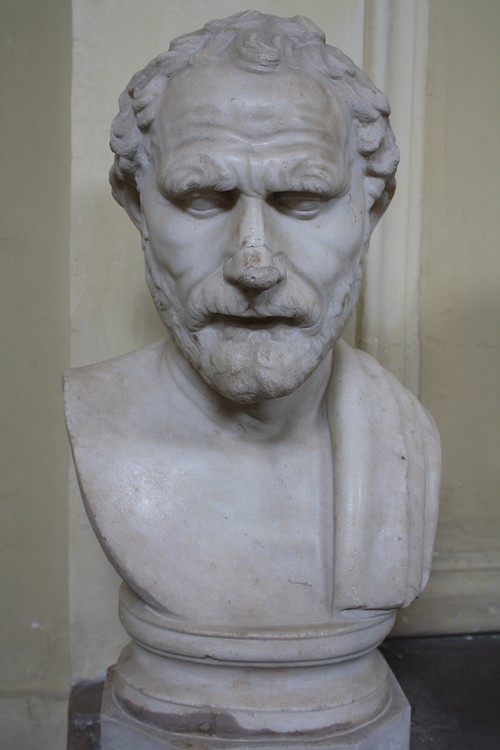
Demosthenes (c. 384 - 322 BCE) was an Athenian statesman who famously stood against Macedonian king Philip II and whose surviving speeches have established him as one of the greatest patriots and powerful orators from ancient Greece. He is not to be confused with the 5th century BCE Athenian general of the same name.
EARLY LIFE & WORKS
Born in c. 384 in Athens, Demosthenes' parents died while he was still only seven years old, and so he then lived under guardianship. Famously, at the age of 18, he prosecuted his guardians for wasting his inheritance, delivered his own speeches in court, and won the case. Studying under Isaeus and working as a speech writer ( logographos ) like his master, his first experience in court was as a prosecutor's assistant. We also know that in 358 BCE he was a grain-buyer ( sitones ). Then, from c. 355 BCE, he came to wider attention when he started to deliver his own speeches in the assembly of Athens.
61 speeches of Demosthenes - both public and private - have survived, along with the rhetorical openings ( prooimia ) for around 50 speeches and 6 letters. Probably, some of that number were speeches given by another orator by the name of Apollodorus but it is, nevertheless, a substantial amount of material. That is, even if, Demosthenes would have given many more speeches than that in his long and illustrious political career. Those that survive show a speaker who could use plain language and lucid argument to devastating effect. He was a master of metaphor but never overused it and, perhaps his greatest and most enduring quality, his work shows an absolute and convincing sincerity.
DEMOSTHENES AIMED HIS ORATORY IN THE ATHENIAN ASSEMBLY AT ONE PARTICULAR TARGET – PHILIP II OF MACEDON WHO SEEMED INTENT ON CONQUERING ALL OF GREECE.
DEMOSTHENES AGAINST PHILIP II OF MACEDON
Demosthenes aimed his oratory in the assembly at one particular target – Philip II of Macedon who seemed intent on conquering all of Greece. The four surviving speeches by Demosthenes on this topic are referred to as the Philippics and date to 351, 344 and 341 BCE. In them, he proposed that Athens prepare for invasion by forming two armies – one of citizens and another of mercenaries. The former would be put on standby while the latter would directly engage with the Macedonians in the north of Greece. The assembly did not take his advice and preferred, instead, the more passive approach of Demosthenes' great political rival Aeschines. The latter once disparagingly described Demosthenes' as, 'the pirate of politics, who sails on his craft of words over the sea of state' (Kinzl, 425)
Demosthenes went on two embassies to Philip's court c. 347 BCE but did not get on well with the Macedonian king or even with his fellow delegates. Returning to Athens Demosthenes' persistently passionate pleas and stark warnings of the dire consequences of rule under Philip were ignored. In one speech he states the threat to Athenian democracy in the following terms,
Do you not see that Philip has titles which are irreconcilable to this? King and tyrant are all enemies of freedom and are the opposite of law. Will you not be on your guard lest in seeking to change from war you find a despot?(3.20)
It was not until his 346 BCE speech On the Peace that the city took a more aggressive stance against Macedon, following the realisation of the ineffectiveness of the Peace of Philocrates. In 344 BCE Demosthenes was sent to Argos and Messene in the Peloponnese to dissuade them from forming an alliance with the dangerous and ambitious Philip. In c. 342 BCE war seemed inevitable and Demosthenes was charged with forming a Hellenic league to withstand the Macedonian army.Demosthenes also pushed the Athenians to ask Persia for assistance and to form an alliance with Byzantium.
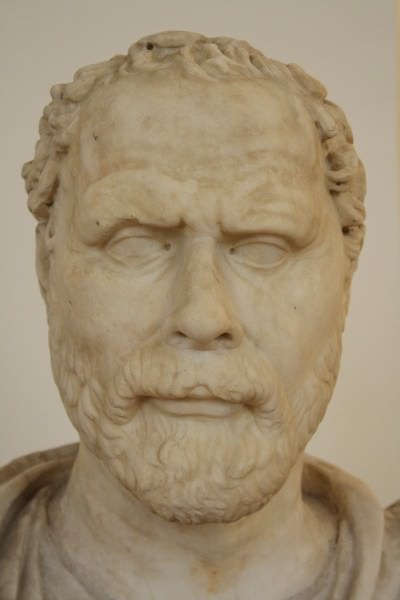
Demosthenes
These political manoeuvres were all to no avail, though. In 340 BCE Philip declared war. As Demosthenes had already warned, Philip had been allowed to build a state of such power that the Greeks were soundly beaten at the Battle of Chaeronea in 338 BCE. The Athenians lost their independence and Demosthenes fled the city in fear of reprisals from Philip.However, when time passed without any action from the Macedonian king, Athens invited Demosthenes to give a funeral speech ( epitaphios ) in honour of the fallen at Chaeronea. The speech survives and is the last made by Demosthenes to do so, even if he made several more important speeches during the reign of Alexander the Great.
Demosthenes was far from finished, though. When Philip was assassinated in 336 BCE, Demosthenes was said to have been so delighted with the downfall of his old enemy that he went dancing in the streets of Athens, decked out in his finest clothes and wearing a garland. However, as Plutarch points out, this was said of Demosthenes by his number one critic Aeschines.Indeed, the whole city of Athens staged official celebrations but there was to be no respite from the Macedonian threat.
THE HARPALOS AFFAIR & EXILE
In 324 BCE Demosthenes' political reputation suffered a major blow when he was accused of taking bribes from Alexanderthe Great's treasurer, a man called Harpalos. The great orator had already been subjected to long-standing accusations of accepting bribes from Persia. Put on trial Demosthenes was found guilty and exiled. A year later, though, Demosthenes was pardoned and allowed to return to Athens after he had made clear just whose side he was on when he advised several Greekcity-states to take advantage of the death of Alexander and re-establish their autonomy by force. Yet again, though, the Greeks were no match for the Macedonians, and in 322 BCE Demosthenes once again had to flee his defeated city. This time he was not let off and the Macedonians followed him to Calauria (modern-day Poros) where, rather than be captured, Demosthenes committed suicide. According to Plutarch, on hearing news of Demosthenes' death his home city erected a bronze statue in his honour with the following inscription,
If only your strength had been equal, Demosthenes, to your wisdom.Never would Greece have been ruled by a Macedonian Ares.
LEGACY
Demosthenes may have been reassessed by modern scholars as a little more opportunistic than the traditional picture of him as a confirmed patriot and it is much debated whether the policies of his political opponents might have better served his city in the end but, certainly, his reputation as a great orator endures. Demosthenes' speeches show the full range of rhetorical technique and were admired in the ancient world as much as they are by modern historians. Cicero, the great Romanpolitician and orator, famously titled his speeches given in the Roman senate against Mark Antony, the Philippics in honour of his illustrious Greek predecessor. Another admirer was Winston Churchill who, in the years leading up to WWII, cast himself as Demosthenes and Hitler as Philip II.
Below is a selection of extracts from Demosthenes' work:
[Aeschines] bids you be on your guard against me, for fear that I should mislead and deceive you, calling me a clever speaker, a mountebank and a sophist and so forth. (Kinzl, 425)
Every deed of violence [is] a public offence. (21.44-5)
The private citizen should not be confused and at a disadvantage compared with those who know the laws, but all should have the same ordinances before them, simple and clear to read and understand. (20.93)
Where is the strength of the laws? If one of you is wronged and cries aloud will the laws run up and stand at his side to assist him? No. They are only writings and could not do this. Wherein then lies their power? In yourselves, if only you support them and make them all-powerful to help whoever needs them. So the laws are strong through you and you through the laws. (21.224)
Denisovan › Origins
Definition and Origins
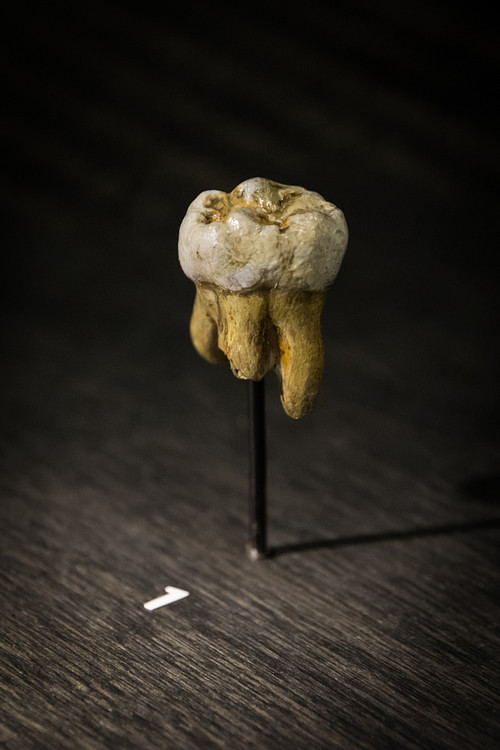
The Denisovans are an extinct group of fossil humans who, along with their sister group the Neanderthals, also share an ancestor with Homo sapiens. Thus far, they are known only from Denisova Cave in the Altai Mountains in Siberia, where a tooth was recently found that bumps up the number of known Denisovan individuals to a grand total of four. This newest specimen is also the oldest, and pushes back the timespan of these humans to at least 100,000 years ago, and maybe even beyond 150,000 years ago, fast-tracking this species into being amongst some of the oldest hominin remains that have so far been found in Central Asia. Denisovans lived at Denisova Cave until at least 48,000-60,000 years ago, indicating they called the Altai region their home (at least at certain times) over a period of tens of thousands of years. They are known to have interbred with Neanderthals; an unknown archaic hominin group that branched off from the human lineage at least one million years ago; and also with the ancestors of today's Melanesians living in Southeast Asia and Oceania. As this last event seems to have happened somewhere in Southeast Asia, far away from the Altai Mountains, we think the Denisovans may have been far more widespread than their currently only known resting place betrays.
DISCOVERY
Nestled in the Altai Mountains in Siberia, near the point where current-day Russia, Kazakhstan, China and Mongolia meet, is Denisova Cave, well known for human occupation stretching back as far as 280,000 years ago and showing signs of occupation by both Neanderthals and Homo sapiens. In 2008 CE, another human was added to this list when the finger bone of a young female was uncovered there and discovered to belong to its own species, dubbed the Denisovans, making the cave a true hotspot. The girl lived between 48,000-60,000 years ago, and paved the way for a somewhat older, male molar found in 2000 CE to be attributed to her species, too. The only other two fossils to receive the Denisovan name tag so far are two further molars: one permanent molar belonging to a male, found in 2010 CE; and, in a recent discovery, a deciduous molar belonging to a very young girl who lived at least 100,000 years ago and possibly even past 150,000 years ago. This greatly pushes back the confirmed time span of this species.

Denisova Cave
SCRATCHING THE SURFACE
Impressively, despite the ever so slightly scarce amount of material associated with the Denisovans, both archaeology and science have come to the rescue and are allowing us to uncover some initial information regarding this species. Sadly, we cannot reconstruct their faces or bodies as of yet, but the three molars that were found show that the Denisovans had very large and robust teeth, which fit in a lot better with older hominins such as Homo erectus, Homo habilis, and even the Australopithecines than they do with our own tiny teeth, or even with the slightly bulkier Neanderthal ones. Big teeth seems to have been a typically Denisovan feature, then - at least for the ones living in the Altai Mountains. Regarding the rest of their features, DNA from our available Denisovans paints a picture of brown eyes set against dark skin, with brown hair topping things off, but, considering Denisovans were probably more widespread, it is likely that more variety existed.
Like their contemporaries, the Denisovans seem to have made tools. The finger bone belonging to the young girl was found in a layer which also contains tools such as micro blades as well as polished stone ornaments that scream Upper Palaeolithic industry (which is normally connected with modern humans), but also side scrapers and Levallois blanks (retouched hand axes made from carefully prepared cores) that tie in with the Middle Palaeolithic. As of yet, both the details and broader features of Denisovan tool use are hard to map out, though.
THEY ARE A SISTER GROUP TO THE NEANDERTHALS & SHARE A COMMON ANCESTOR WITH THEM - THE TWO GROUPS DIVERGED BETWEEN C. 190,000-C. 470,000 YEARS AGO.
Most studies published on these guys are of the genetic kind, however, and can tell us such neat things as, for example, how diverse the Denisovan population may have been. Strikingly, even though all of our current Denisovan fossils only stem from a single location – Denisova Cave – they seem to have been at least equally diverse as the Neanderthals were across their almost arrogantly widespread geographical range, as well as falling within the lower range of diversity seen in modern humans today. Of course, this Altai-based group of Denisovans could conceivably have been fairly isolated, and it is entirely possible that the Denisovans over their whole suggested geographical range may have been more varied. Some strokes of luck in finding additional fossils would be very, very welcome.
The wonderful world of genetics is also narrowing down where the Denisovans fit on the human lineage. It is clear that they are a sister group to the Neanderthals and share a common ancestor with them - the two groups diverged between an estimated 430,000-473,000 years ago – but also that this Neanderthal-Denisovan branch shares an ancestor with our own Homo sapiens species. The branch that would lead towards both Denisovans and Neanderthals on the one hand, and the branch that would develop into modern humans on the other hand, split off from each other around an estimated 765,000-550,000 years ago. This evolutionary connection is only the beginning, though – the extent of our ties with both of these groups makes for even better news headlines.
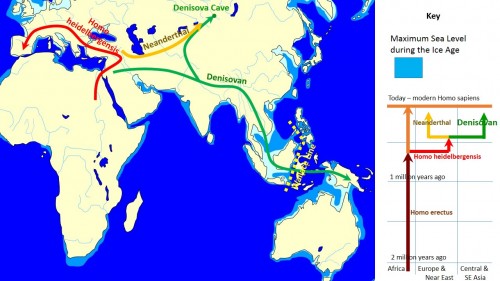
Spread and Evolution of Denisovans
WEB OF CONNECTED HUMANS
By now, evidence is positively piling up that is finally overthrowing the old idea of linear evolution (one species evolves into the next, which evolves into the next, and so forth). As John Hawks suggests, the evolutionary history of the genus Homo probably looked more like a river delta, with streams weaving in and out, connecting and disconnecting, some branching off and landing in the sand and others continuing on. Different groups of humans met and interbred at various times and places, with genes being exchanged all over the place. Our ever-helpful Denisovans have greatly served to underpin this notion because apart from the already known gene flow from Neanderthals into non-African modern humans (~2% Neanderthal ancestry), we now know there was also gene flow from Neanderthals into Denisovans; from an unknown archaic human into the Denisovans;and, around an estimated 44,000-54,000 years ago, from Denisovans into the ancestors of present-day Melanesians living on Southeast Asian islands and in Oceania (~2-4% Denisovan ancestry). This Denisovan component also occurs in diluted version across the Asian mainland and the Americas, and at lower levels it is widespread among modern humans in general, thanks to our wanderlust and desire to migrate all over the place.
WHEN HOMO SAPIENS BECAME THE NEW KID ON THE EURASIAN BLOCK, THEY GENETICALLY BENEFITED FROM THE EXCHANGE WITH THE LONG SINCE ESTABLISHED NEANDERTHALS & DENISOVANS.
Evolutionary geneticist and ancient-DNA pioneer Svante Pääbo summarises this apparent chaos in suggesting that '… our ancestors were part of a web of now-extinct populations linked by limited, but intermittent or sometimes perhaps even persistent, gene flow.' (Pääbo, S. 'The diverse origins of the human gene pool', 313). We know when it comes to the Neanderthal-Denisovan mixing, at least, that the circumstances were certainly right: the Denisovan occupation of Denisova Cave overlaps with when Neanderthals are known to have made themselves comfortable in this same cave, too, which makes it easy to envisage these two groups (literally) bumping into each other from time to time. Moreover, it is because of the big chunk of Denisovan DNA in Melanesians that we think they must have been more widespread than just the Altai Mountains.
The cool thing is, when the main wave of Homo sapiens that journeyed out of Africa around 55,000 years ago became the new kid on the Eurasian block, they genetically benefited from the exchange with the long since established Neanderthals and Denisovans. We already knew that Sapiens stole some skin- and hair colour genes that were more suited to the northern ranges of the world when they interbred with Neanderthals, but they also gained a nice immune system boost from both of these species, who were already very much adapted to local Eurasian pathogens while Sapiens was not. This would have helped defend modern humans against the new array of parasites and bacteria. More traits courtesy of the Denisovan mixing are coming to the fore, too, such as the ability of Tibetans to cope with dizzyingly high altitudes.
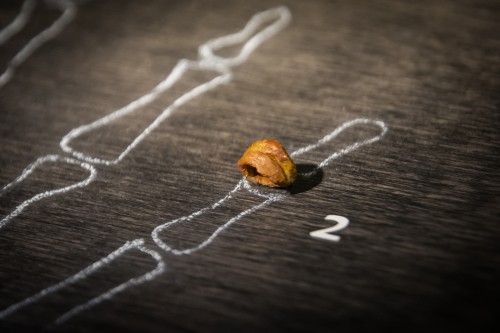
Denisovan finger bone
However, just like with the cosy connection with the Neanderthals, it seems the Sapiens-Denisovan connection also caused some problems. Certain bits of DNA inherited from them turned out to be harmful and were aggressively selected against, and it seems male mixed children may even have been sterile, indicating that although these groups of humans shared ancestors and could obviously make babies together, they were actually different enough to only just be biologically compatible.
THE FUTURE
It is incredible that through a few fossils and accompanying titbits belonging to only four individuals, from one cave nestled high in the Siberian Altai Mountains, scientists have managed to extract enough information to fill an entire definition on this website. To really paint a proper picture of who the Denisovans were, what it would be like to stare into their faces, how tall or stocky they were, and what their lifestyle and culture was actually like, how far spread out they were across the world and who exactly they bumped into, we need to get digging and get very lucky. More Denisovan-related finds would help to balance out our information and stretch it beyond mostly genetics. Bring on the future so we can fill in the past, please.
Food & Agriculture in Ancient Greece › Origins
Ancient Civilizations
The prosperity of the majority of Greek city -states was based on agriculture and the ability to produce the necessary surplus which allowed some citizens to pursue other trades and pastimes and to create a quantity of exported goods so that they could be exchanged for necessities the community lacked. Cereals, olives, and wine were the three most produced foodstuffs suited as they are to the Mediterranean climate. With the process of Greek colonization in such places as Asia Minor and Magna Graecia Greek agricultural practice and products spread around the Mediterranean.
A NETWORK OF SMALLHOLDINGS
The state did not control farming and crops were grown and livestock reared by private individuals on their own land. Indeed, the widespread practice of not permitting non-residents to own land meant that smallholdings were the norm. Another important factor which limited the amalgamation of land plots over time was that male children generally inherited equal shares of their parents' land. Farms at Athens ranged in size from 5 ha (the poorer citizens) to 5-10 ha (middle class) and 20 ha (the aristocracy). In Sparta farms were a little bigger on average, ranging from 18 ha for the smaller ones to 44 ha for those belonging to the richest citizens. The poorest citizens had no land at all and so, if they had no other skills of benefit to the community such as crafts, would have worked on the land of others for pay or leased land to work it themselves.
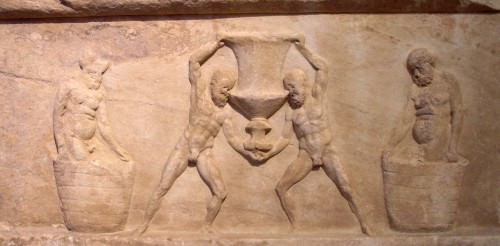
Satyrs Making Wine
It is not clear if farmers always lived on their farms or resided in the city and travelled each day. It seems reasonable to suppose there was a mixture of both approaches which was probably dependent on the location of the land inherited by an individual (ie the proximity to the city and separation from other plots they owned) and their personal status such as being able to afford slaves (or helots in the case of Sparta) to work the land.
ONLY ONE-FIFTH OF GREECE HAS ARABLE LAND SO PRESSURE TO MAKE BEST USE OF IT WAS HIGH.
CROPS
The crops produced by the ancient Greeks were, of course, selected for their suitability to the Mediterranean climate. This has a combination of dry hot summers with mild winters providing plentiful rainfall. The irregularity of annual rainfall did mean that crop failure was a regular problem, though. Wheat crops may have failed once every four years and barley crops once every ten years because of insufficient water supply. Terrain, localised weather conditions, and different soils were also factors in making some areas more fertile than others. Indeed, as a whole, only one-fifth of Greece has arable land so pressure to make best use of it was high.
The most widely cultivated crop was wheat - especially emmer ( triticum dicoccum ) and durum ( triticum durum ) – and hulled barley ( hordeum vulgare ). Millet was grown in areas with greater rainfall. Gruel from barley and barley-cakes were more common than bread made from wheat. Pulses were grown such as broad beans, chickpeas, and lentils. Vines to make wine and olives to produce oil completed the four main types of crops in the Greek world. Fruit (eg figs, apples, pears, pomegranates, quinces, and medlars), vegetables (eg cucumbers, onions, garlic, and salads) and nuts (eg almonds and walnuts) were grown by many private households.

Silver Stater, Metapontum
CROP MANAGEMENT
Ploughing and sowing was carried out in October-November-December. It is interesting to note that there were no distracting religious festivals or records of Assembly meetings in Athens during this crucial and busy period. Vines were pruned back in the early spring, and grain harvested in May-June. Winnowing, threshing, and storage were done in June-July while grapes were gathered and made into wine and figs collected in September. In the autumn olives were harvested and pressed into oil.During the winter some hardier crops were sown and fields maintained.
There is evidence of crop rotation, and fields were left fallow to allow soil nutrients to regenerate and moisture to build up. In more pressing times some fields would have been used continuously throughout the year or planted with multiple crops at the same time. Such crops as beans and lentils were also grown and reploughed back into the field to re-fertilise it or weeds could be left to grow as food for grazing animals. Small plots used for growing fruit and vegetables would have been irrigated with small water channels and cisterns. Trenches, if labour were available, were dug around trees to hold precious rainwater for where it was most needed.
Equipment used in Greek agriculture was basic with digging, weeding, and multiple ploughing done by hand using wooden or iron-tipped ploughs, mattocks, and hoes (there were no spades). Richer farmers had oxen to help plough their fields. Sickles were used to harvest crops, which were then winnowed using a flat shovel and baskets. Grains were then threshed on a stone floor which was trampled on by livestock (and which might also have dragged sledges for the purpose too). Grapes were crushed underfoot in vats while olives were crushed in stone presses.

Fish Plate
ANIMAL HUSBANDRY
The ancient Greeks did not manage large herds of livestock for the purposes of creating a saleable surplus and specialised pastoralism, with its necessity to seasonally move animals between pastures in different climate zones (transhumance), is not recorded until the Classical period in Greece. However, many private households would have kept a small number of animals, perhaps no more than 50 in a herd would have been the norm. These included sheep, goats, pigs, chickens, and some cattle.They were useful for their meat, milk to make cheese (it was rarely drunk), eggs, wool or leather, and to fertilise crops. Animals were reared in greater numbers where the local terrain was not suitable for agriculture. These animals, besides having access to naturally occurring areas of grazing, were fed fodder of chaff and straw, stalks of vegetable plants, fallen and damaged fruit, and the residues of grapes and olives after pressing. Horses, mules, and donkeys were also reared for transport.
TRADE OF FOODSTUFFS
Most farmers would have only produced sufficient foodstuffs for their own family's needs but they would have bartered surplus produce for everyday necessities and foodstuffs they did not produce themselves such as cheese, honey, fish, and shellfish.Some of the wealthier citizens with larger plots did certainly produce cash crops which they could sell in bulk at markets.Agricultural products traded within Greece between citizens at markets and different cities included cereals, wine, olives, figs, pulses, eels, cheese, honey, and meat (especially from sheep and goats). From the 5th century BCE, Athens' port of Piraeusbecame the most important trading centre in the Mediterranean and gained a reputation as the place to find any type of goods on the market.
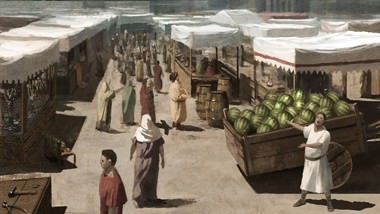
Market Scene
Greek merchant ships plied the Mediterranean and exported goods to such places as Egypt, Magna Graecia, and Asia Minor.Foodstuff exports included wine, especially from Aegean islands like Mende and Kos, olives and olive oil (transported, like wine, in amphorae ). By-products such as hides were exported too, especially from Euboea. Many Greek city-states continued to function as important trade centres throughout the Hellenistic and Roman periods, especially the free-trade ports of Athens, Delos, and Rhodes.
STATE INTERVENTION
The involvement of the state in trade and the sale of agricultural products was relatively limited; however, a notable exception was grain, imported from Egypt and the Black Sea area, to ensure that in times of drought populations did not starve. For example, so vital was it to feed Athens' large population that trade in wheat was controlled and purchased by a special 'grain buyer' ( sitones ). From c. 470 BCE the obstruction of the import of grain was prohibited, as was the re-exportation of it; for offenders the punishment was the death penalty.
Market officials ( agoranomoi ) ensured the quality of goods on sale in the markets and grain had its own supervisors, the sitophylakes, who regulated that prices and quantities were correct. Although city-states did often impose taxes on the movement of goods and levies on imports and exports at ports, there were also measures taken to protect internal trade and more heavily tax goods which were destined for, or came in from, areas outside Greece. There were also trade incentives such as on Thasos to encourage the export of their high-quality wine.
LICENSE
Article based on information obtained from these sources:with permission from the Website Ancient History Encyclopedia
Content is available under License Creative Commons: Attribution-NonCommercial-ShareAlike 3.0 Unported. CC-BY-NC-SA License